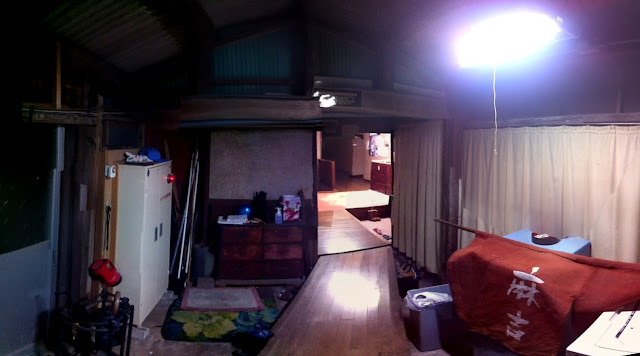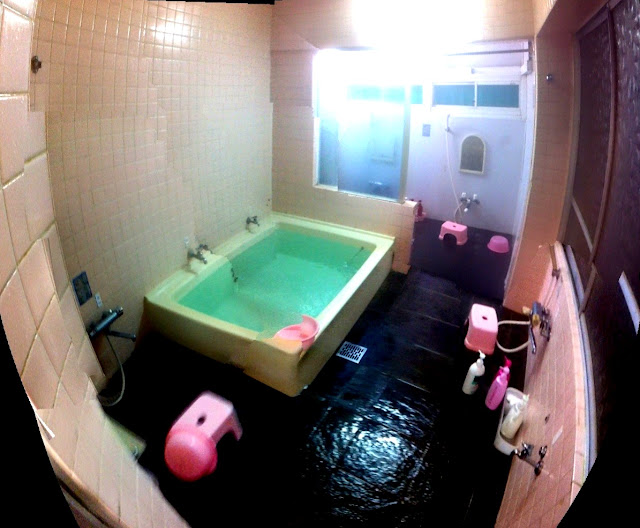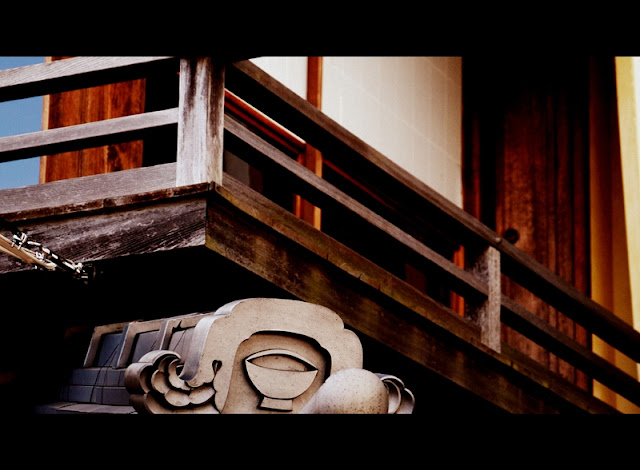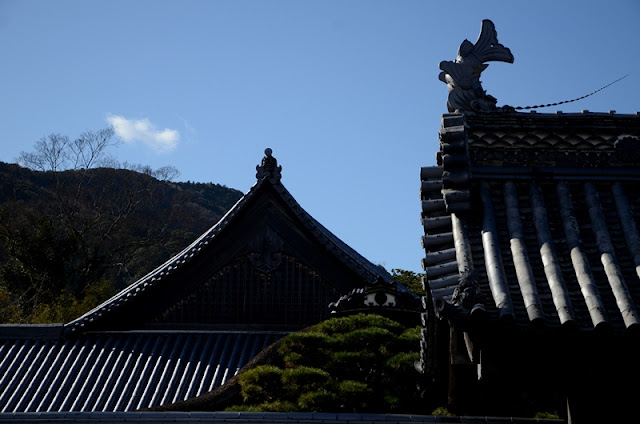Ise shi Town - 伊勢市
Last day
day in Ise shi and this time I was ready to see what this village had to
offer to the tourists apart from the Ise Jingu Grand Shrine.
We woke up late that day and I have to say that you have to be ready for
the old houses in Japan. Even though they’re above the ground and they’re built using wood, that doesn't mean you’ll feel warm. The room
was quite good because we had the heater on the whole night. My recommendation is to remember to bring a
sweater or a base layer to keep you warm when you go off the room.
 |
| 麻吉旅館 asakichi ryokan flowers |
 |
| 麻吉旅館 asakichi ryokan passage |
 |
| 麻吉旅館 asakichi ryokan main room |
I forgot to
mention something in the previous post about the room in the Inn. If you’re as
passionate about Japan as I am then you might like this I’m going to tell you.
The Inn we stayed in Ise, despite being very old (Meiji Period – 明治時代 Meiji-jidai - mid 19th Century to beginning of 20th Century) it is in very good condition. The room like I was saying is separated from the other room with a paper wall door – proper old style! The only downside to it is that if you want to fart- well, I think you’ll have to think twice.
The Inn we stayed in Ise, despite being very old (Meiji Period – 明治時代 Meiji-jidai - mid 19th Century to beginning of 20th Century) it is in very good condition. The room like I was saying is separated from the other room with a paper wall door – proper old style! The only downside to it is that if you want to fart- well, I think you’ll have to think twice.
The shower
room in Japan is so different from the one you’re used to in the West that in the
beginning is quite shocking. Imagine coming inside a steamy room with a shower
head, a bathtub (with a rather unusual size) and a Japanese stool. Trust me,
that’s like nothing you've ever seen before.
There’s nothing wrong with it I actually love it now that I’m used to it. Funny thing is that I didn’t get inside the bathtub the first time I saw it, I just didn't know you can get it. I thought it was the well and people should not seat inside. You can laugh now!
There’s nothing wrong with it I actually love it now that I’m used to it. Funny thing is that I didn’t get inside the bathtub the first time I saw it, I just didn't know you can get it. I thought it was the well and people should not seat inside. You can laugh now!
 |
| 麻吉旅館 asakichi ryokan bathroom |
Anyway,
this was the last day and we packed everything and said good bye to the owner
of the hotel and here comes another anecdote to remember and show to the world
how great the Japanese society is. After we paid and we said good bye I never
understood why the lady didn’t leave us alone. She helped us with the suitcase
(she would just not let us carry the suitcase to the car) and brought them to
the car.
My friend
and the lady exchanged a couple of bows as a sign of respect and also my friend
asked her a couple of things about the town. After all the good-byes, good luck and bows - we’re off! Wait the owner of
the hotel is still standing there (and it’s cold and she’s not wearing any jacket). “What is she doing?” I asked my friend: She told me that Japanese hospitality
tradition is a bit different from the western style. We left the car park of
the Inn and the lady was standing there and even when we turned left the owner
bowed a last time.
I can’t stress how nice that was. It’s different but such respect and care for the customer you don’t find it any other place in the world (and I've been in many places so far). Indian people are also like that a bit but they're missing the bows though.
I can’t stress how nice that was. It’s different but such respect and care for the customer you don’t find it any other place in the world (and I've been in many places so far). Indian people are also like that a bit but they're missing the bows though.
Ise Shi Town – food, hand crafts, people and whatnot
We got to
the town and to find an empty car park was going to be a bit of an adventure
since tons of people seemed to have come to the town overnight.
Seriously the day before only half of the people were there and it did not feel even as crowded as the second day. In case you’re wondering no, I did not have onigiri instead I had bought a huge wafer filled with some kind of sweet paste which I can’t remember its name. It’s quite tasty, sweet and hard to the teeth so I recommend you to get a green tea – it goes very well together. I actually bought the same a couple of times later on my trip in Kurashiki.
Seriously the day before only half of the people were there and it did not feel even as crowded as the second day. In case you’re wondering no, I did not have onigiri instead I had bought a huge wafer filled with some kind of sweet paste which I can’t remember its name. It’s quite tasty, sweet and hard to the teeth so I recommend you to get a green tea – it goes very well together. I actually bought the same a couple of times later on my trip in Kurashiki.
 |
| Japanese wafer |
So we found
a car park a bit far away from everything but it was ok. The main street of the
town might not be longer than a kilometre but it has so many shops and
restaurants that it can easily take you a whole day to visit every single shop. We
started walking very close to the Naiku Shrine entrance and even though I wasn’t
hungry I started seeing things I wanted to try straight away. However, my
friend and I decided to hold it and walk the entire street and then buy or try
whatever we wanted on the way back. After walking it I can say that’s the best
thing to do, otherwise you wouldn't leave room to try new things.
 |
| Ise 伊勢市 - main shopping street |
You’ll see
many things that most likely you will see or would have seen before in other
towns around Japan around the same time of the year. Yet, the town has a
different air to Osaka and Kyoto. Not only in terms of size but you
do feel like you’re in a more traditional Japanese environment. On the way we saw
nice place of worship. It had a massive stone and the red autumn colour of the
leaves made the place quite beautiful. I still could not believe how lucky I
was to experience part of the autumn colours in mid-December.
As we walked along the street we
could see that lots of people were buying a lot of food to take with them to
their cities or towns.
It was a perfect sunny day with a nice chill in the air – perfect for a day out. We kept on walking towards the end of the street and we found this old house with the typical Chinese roof and the very Japanese style mark of the house owner. I think the first time I saw that style I was 10 years old or a bit older – I immediately fell in love with it. In Ise Shi I found two that were very nice but one of course was more interesting that the other one. The one I liked had the picture of a rice bowl – very Japanese.
It was a perfect sunny day with a nice chill in the air – perfect for a day out. We kept on walking towards the end of the street and we found this old house with the typical Chinese roof and the very Japanese style mark of the house owner. I think the first time I saw that style I was 10 years old or a bit older – I immediately fell in love with it. In Ise Shi I found two that were very nice but one of course was more interesting that the other one. The one I liked had the picture of a rice bowl – very Japanese.
When we got
to the end of the street I saw this particular and well-decorated subway. Inside the
subway you could see the history of how Ise Jingu used to be back in the days.
Unfortunately, there’s nothing much written in English but if you’re lucky and
happen to be with a friend then she/he can help you out.
As you can
see on the video when we got to “K” convenient shop we turned back and went
back to the main street. By the time we got the handicraft zone of the town it
was 13:00 and both my friend and I were starving.
We started looking for a place which would sell fish and we asked around here and there and finally we found a place good enough to fill in our bellies.
We started looking for a place which would sell fish and we asked around here and there and finally we found a place good enough to fill in our bellies.
They had
many things on the menu but I told my friend to please pick something typical from
the city and so they brought something delicious. Green tea to start the lunch, followed by the food.
The fish I don’t really know how to explain it, because even my friend had problems to explain me but this is how I can describe it to you: imagine the way unagi is grilled with the special sauce they add to it when they are grilling it. However, this is not unagi but tuna. Then you get a type of a bowl with rice on the bottom and the grilled fish on top of it. The way of putting the rice and fish like that I thought it was typical from Kyoto because it was the first time I had tried it, but later I found out that this is the way fish is served in most places in Japan. Yes, we Westerners are a bit wrong thinking that sushi is only rolls.
The fish I don’t really know how to explain it, because even my friend had problems to explain me but this is how I can describe it to you: imagine the way unagi is grilled with the special sauce they add to it when they are grilling it. However, this is not unagi but tuna. Then you get a type of a bowl with rice on the bottom and the grilled fish on top of it. The way of putting the rice and fish like that I thought it was typical from Kyoto because it was the first time I had tried it, but later I found out that this is the way fish is served in most places in Japan. Yes, we Westerners are a bit wrong thinking that sushi is only rolls.
 |
| clam and egg roll |
 |
| squid |
 |
| grilled tuna |
 |
| natou |
 |
| boiled octopus and caviar |
 |
| oyster |
 |
| pickels |
 |
| salmon |
 |
| soup |
 |
| teishoku in Ise shi - 定食 伊勢市 |
Handicraft zone in Ise-shi 伊勢市
After lunch we went to see what the handicraft people had to offer, and they had lots of cool things to see and buy!
The first place we stopped by was very close to the main square (I don’t know if it’s an actual square but that’s how I saw it) in a stand with a lovely old couple who were making Geta (Japanese sandals). In case, you haven’t watched any Japanese movie before Geta is a wooden sandal, very Japanese and very difficult to walk on them too. Why? Well, because they are special, but I’m not going to tell you anything – just see it by yourself on the picture below.
The first place we stopped by was very close to the main square (I don’t know if it’s an actual square but that’s how I saw it) in a stand with a lovely old couple who were making Geta (Japanese sandals). In case, you haven’t watched any Japanese movie before Geta is a wooden sandal, very Japanese and very difficult to walk on them too. Why? Well, because they are special, but I’m not going to tell you anything – just see it by yourself on the picture below.
Ok, it's true, this is
not the typical geta, this is for stability and balance practice but the owner
of the stand told me to try to give it a go and so I did. Even though I look
very stable and comfortable on them I must say they were quite difficult to stand on.
Normally the typical geta has two wood support instead of one but these pair were special as I said on the previous paragraph. They were so nice that they even offered me a customised one but they didn't have a geta big enough for me elephant-like feet so I bought the normal with black stripe.
It was here when I also saw how efficient the Japanese society works. I asked them if I could pay with card and they said yes but they didn't have a telephone – let alone any kind of electronic devices – the old lady took me all around the handicraft zone that I wanted to discover from one alley to another quick quick quick.
She was very funny – always making sure I was following her. We got to a nice shop that sold everything but getas. I was a bit confused because I thought they would also sell getas but no, not a single one. That means that either the couple owns the place or they’re very good friends with the owner of that other shop.
Normally the typical geta has two wood support instead of one but these pair were special as I said on the previous paragraph. They were so nice that they even offered me a customised one but they didn't have a geta big enough for me elephant-like feet so I bought the normal with black stripe.
It was here when I also saw how efficient the Japanese society works. I asked them if I could pay with card and they said yes but they didn't have a telephone – let alone any kind of electronic devices – the old lady took me all around the handicraft zone that I wanted to discover from one alley to another quick quick quick.
She was very funny – always making sure I was following her. We got to a nice shop that sold everything but getas. I was a bit confused because I thought they would also sell getas but no, not a single one. That means that either the couple owns the place or they’re very good friends with the owner of that other shop.
After
paying she left and told us to come back any time. I can tell you that living
experiences like that really make me want to go to Japan asap. I know it’s different
to live in Japan than visiting Japan but I feel it’s so nice.
Anyway, we looked around the shop and then we decided to start the tour from that shop since we had barely seen anything about it. So many things I wanted to buy and so ridiculously cheap compared to the big cities.
Anyway, we looked around the shop and then we decided to start the tour from that shop since we had barely seen anything about it. So many things I wanted to buy and so ridiculously cheap compared to the big cities.
There were
soooo many people everywhere and walking here and there we saw people shooting
airguns trying to hit the prize.
Ise is a
great place to visit and even though at the end of the first day I said well
there’ nothing else to see, visiting the handicraft zone proved me wrong. There
are many good shops and really good things to try. Sadly, shops close very
early during winter but whatever you do you must buy at least one or two or
three chestnut buns. That is heavy indeed but if you can manage to eat them –
trust me it won’t disappoint you at all.
Yes, that too – you will find that Japanese chestnuts are not as heavy as the European or American. That said, it doesn't mean you can stuff yourself with chestnut but after having tried many different version of chestnut pastries I can tell you that they are lighter than the other ones.
Yes, that too – you will find that Japanese chestnuts are not as heavy as the European or American. That said, it doesn't mean you can stuff yourself with chestnut but after having tried many different version of chestnut pastries I can tell you that they are lighter than the other ones.
And so our
time in Ise was coming to an end and I was getting ready to go to Nara alone
since my friend had to go back to work.
I was a bit sad of leaving this amazing town, perhaps too small and no nightlife at all but I was excited about the days to come. Nara was also amazing and you’ll see some funny videos and also cute pictures too.
I was a bit sad of leaving this amazing town, perhaps too small and no nightlife at all but I was excited about the days to come. Nara was also amazing and you’ll see some funny videos and also cute pictures too.
I’m going to end this video with some shots from the train on the way to Nara and see you soon on the next post.





No comments:
Post a Comment